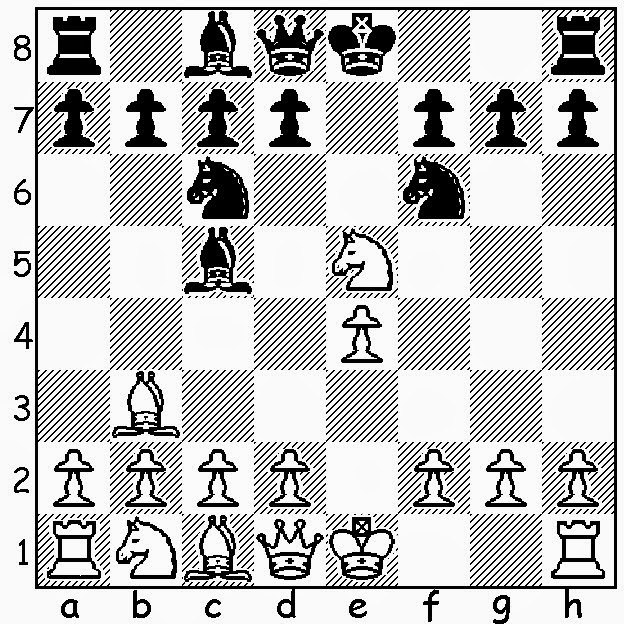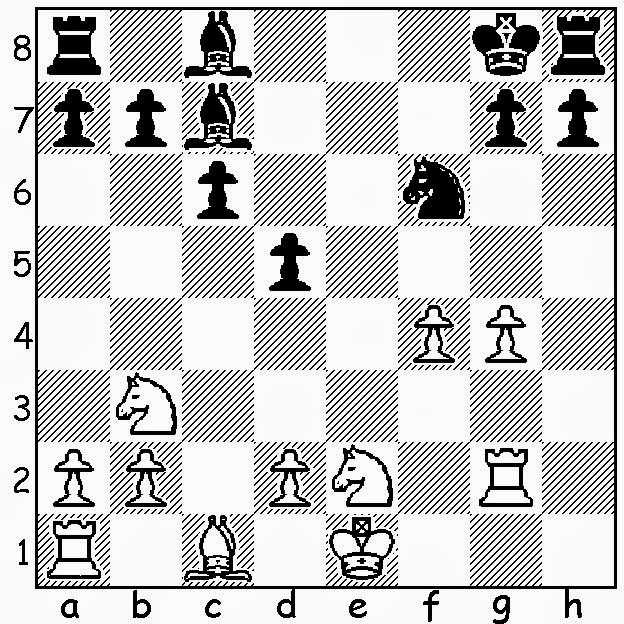1.e4 e5 2.Nf3 Nc6 3.Bc4 Bc5 4.Bxf7+ ...and related lines
(risky/nonrisky lines, tactics & psychology for fast, exciting play)
Friday, March 14, 2014
Not Quite Jerome-Inspired Games (Part 3)
In the following three minute game, Black contrives a maneuver to strengthen his Kingside and drive away the enemy Queen. Much to his surprise, it allows White to sacrifice Her Majesty and deliver checkmate!
Philidor 1792 - guest681
3-minutes blitz www.bereg.ru, 20.12.2013
1.e4 e5 2.Nf3 Nc6 3.Bc4 Nf6 4.Bb3 Bc5 5.Nxe5
White bypasses a possible Delayed Jerome Gambit (5.Bxf7+) and sacrifices his Knight without sacrificing the Bishop.
5...Nxe5 6.d4 Qe7
Houdini suggests that after 6...Nxe4 7.0-0 0-0 8.dxe5 Qe7 the game would be even.
7.0-0 Bxd4 8.Qxd4 h6 9.Nc3 d6 10.f4 Nc6 11.Qd3 0-0
12.Bd2 Bg4 13.Rae1 Bh5 14.e5 dxe5 15.fxe5 Nh7 16.Nd5 Qh4
17.Re3 Bg6 18.Qxg6 fxg6 19.Ne7+ Kh8 20.Nxg6 checkmate
Wednesday, March 12, 2014
Not Quite Jerome-Inspired Games (Part 2)
Here we have another manic three-minute game showing the three secrets to winning blitz chess: attack, attack, attack.
Philidor 1792 - guest2151
3-minutes blitz www.bereg.ru, 24.12.2013
1.e4 Nf6 2.Bc4 e5 3.Nf3 Nc6 4.Bb3 a5
After offering an Alekhine Defense, but showing no interest in participating in the Krejcik Gambit, Black finds an interesting way to avoid a Delayed Jerome Gambit.
White goes for a Chicago or Halloween Gambit, sacrificing a Knight on e5 (without having sacrificed the Bishop on f7). Of course, 5.Nc3 would have been just fine for White.
5.Nxe5 Nxe5 6.d4 Nc6 7.d5 Ne5 8.f4 Ng6 9.e5 Ng8
10.h4 Nxh4 11.d6 cxd6 12.Qh5
12...Nxg2+ 13.Kf2 g6 14.Qh3 dxe5 15.Qxg2 exf4
16.Qd5 Qb6+ 17.Kf3 d6 18.Qxf7+ Kd8 19.Qxf8+ Kc7 20.Qg7+ Black resigned
Monday, March 10, 2014
Not Quite Jerome-Inspired Games (Part 1)
Our chessfriend Philidor 1792 is on such a tactical roll, it seems a shame to not present three smashing games of his, just because they don't fit the Jerome Gambit template.
Here is the first. It contains a reminder (again) that even in 3-minute games, endgame skill is essential.
Philidor 1792 - guest3658
3 0 blitz, www.bereg.ru, 27.12.2013
1.e4 e5 2.Nf3 Nc6 3.Bc4 Nf6 4.Bb3 Be7 5.Nxe5
White, unable to reach a Delayed Jerome Gambit (i.e. 4...Bc5, 5.Bxf7+) switches to an opening reminiscent of the Chicago or Halloween Gambit.
5...Nxe5 6.d4 Nxe4
This looks a bit like I know you want me to play 6... Nc6, so I'll play something else... The problem - for Black - is that 6...Nc6 is the correct move, whereas the text leads to an equal game.
As in the Jerome Gambit, returning the sacrificed material for an even game is often the price a defender is willing to pay.
7.dxe5 O-O 8.Qd4 Nc5 9.Nc3 Nxb3 10.axb3 c6 11.Bf4 Bg5 12.O-O-O Bxf4+ 13.Qxf4
White would like to make something out of Black's backward d-pawn, or White's strong point at d6.
13...f5 14.Rd3 g5 15.Qc4+ Kh8 16.g4
Sharper was 16.h4.
16...Qe7 17.Re1 fxg4 18.Re2 Rf4 19.Rd4 Qf7 20.Qxf7 Rxf7
White's lead in development clearly compensates for Black's extra, doubled pawn. In turn, Black decides to give two pawns to activate his pieces.
21.Ne4 d5 22.exd6 Bf5 23.Nxg5 Rg7 24.Ne6 Bxe6 25.Rxe6 Rd8
White's advantage lives at d6.
26.Re7 Kg8 27.Rxg7+ Kxg7 28.Rxg4+ Kf6 29.Rh4 Rd7 30.c4 c5 31. b4 b6 32. bxc5 bxc5 33.b4
33...Rxd6 34. Rh6+ Ke5 35.Rxd6 Kxd6 36.b5 Ke5 37.Kc2 Kd4
Black's King has taken up a strong position, and now only one move keeps the advantage for White. Which one?
38.f4
White needed to find 38.Kb3! when Black's King cannot safely choose either side of the board to play on. White's King clearly wants to advance and capture Black's pawn on a7, followed by promoting his b-pawn. Black cannot stop that, and White's f-pawn at the same time.
Houdini gives as best play (30 ply) 38...Ke4 39.Ka4 Ke5 40.b6 axb6 41.Kb5 Kd4 42.f4 h5 43.f5 Ke5 44.Kxb6 Kxf5 45.Kxc5 and White's King will lead his passed pawn to the Queening square.
38...Kxc4
Black misses his opportunity, as 38...Ke4 would now win, as the tempos now favor him.
Now the game is even.
39.f5 Kd5 40.Kd3 Ke5 41.Kc4 Kxf5 42.Kxc5
42...h5
The wrong kind of activity. Instead, 42...Ke5 would hold the draw.
43.Kc6 h4 44.Kb7 h3 45.Kxa7 Kf4 46.b6 Kf3 47.b7 Kg2 48.b8=Q Black resigned
Saturday, March 8, 2014
More Jerome-Inspired Games (Part 4)
In the following 3-minute game, White only head-fakes toward a Jerome Gambit, but the resulting opening still features a piece-for-a-pawn sacrifice, and some foot soldiers who would not be out of place in Jerome's Double Opening.
Philidor 1792 - guest1132
3 0 blitz, www.bereg.ru, 15.12.2013
1.e4 e5 2.Nf3 Nc6 3.Bc4 Nf6 4.Bb3 Be7 5.Nxe5
This unusual Two Knights Defense, possibly heading for a Delayed Jerome Gambit with 4.Bb3 - had Black played 4...Bc5 - now takes a Chicago Gambit or Halloween Gambit turn with this Knight sacrifice.
5...Nxe5 6.d4 Ng6 7.e5 Ng8 8.Qf3 f6
Instead, Houdini suggests 8...d5 9.exd6 Bf6 10.Qe2+ Kf8 11.dxc7 Qxc7.
9.Qd5 d6
An improvement over 9...Nh6 10.Bxh6 Rf8 11.Bxg7 c6 12.Qc4 d5 13.exd6 Qxd6 14.Bxf8 Black resigned, Philidor 1792-guest1063, www.bereg.ru, 2013.
10.Qf7+ Kd7 11.e6+
It is tempting to get after the enemy King, although Houdini prefers letting it go in exchange for winning back a piece and turning the whole board to chaos: 11.exd6 cxd6 12.h4 Nh6 13.Bxh6 gxh6 14.h5 Nf4 15.g3 Rf8 16.Ba4+ Kc7 17.Qc4+ Kb8 18.gxf4 d5.
11...Kc6 12.Nc3 Nh6 13.Be3
Offering the Queen for a mate-in-one.
13...d5 14.Bxh6 gxh6 15.Nxd5
15...a5 16.c4 Qf8 17.h4 a4 18.Bc2 Qxf7 19.exf7 Kd6 20.h5 Nf8 21.0-0-0 Be6
22.Rhe1 Bd8 23.Nc3 Bxf7 24.c5+ Kd7 25.Bf5+ Kc6 26.Be4+ Kd7 27.Bf5+ Draw
Thursday, March 6, 2014
Before This Blog Began...
Before I started this blog (see "Welcome") I had a series of Jerome Gambit-related posts at www.chesshistory.com (under the "Puzzles and Mysteries" section) from 11/24/01 to 9/6/04. A lot of topics were explored, and some paths crossed and re-crossed, as I was finding my way in the world of "Jerome's Double Gambit".
Probably the funniest episode was my mis-guided search for the imaginary book All or Nothing! The Jerome Gambit, by Chiam Schmendrick...
Trips to the White Collection in the Cleveland Public Library helped fill in the gaps of my knowledge, as did the contribution of many chessfriends world-wide.
Following that "debut", I started to find my "voice" in the ChessPub Forum (www.chesspub.com), a discussion forum for ChessPublishing.com, from 1/19/05 to 12/29/07. What began as a series of posts by me, responding to others, quickly became a series of posts by me, responding to me -- and I was eventually dis-invited to continue.
[Although there was a bit of a fall-off from the previous months, the number of visitors to this blog in February 2014 was the best for a February since I began posting. Welcome, again - and many thanks for visiting! - Rick]
Tuesday, March 4, 2014
More Jerome-Inspired Games (Part 3)
Once again, chessfriend Philidor 1792 shows the "hidden" trap in many Jerome Gambit games - Black may be able to solve all of the problems thrown at him, but if he is incautious in his use of time, the falling flag will undo him - regardless of his advantage on the board.
Philidor 1792 - guest2044
3 0 blitz, www.bereg.ru, 2013
1.e4 e5 2.Bc4 Nf6 3.Nf3 Nxe4 4.Bxf7+
4...Kxf7 5.Nxe5+ Kg8 6.Qf3 Nf6 7.g4 Qe8
As in Rumagoso - Godzillainchains, PlayChess.de, 2003, (0-1, 24); see Philidor 1792 - guest564, 3 0 Blitz, www.bereg.ru, 2013 (1-0, 58).
8.Qb3+ Qe6
Better 8...d5.
9.Qxe6+ dxe6 10.Nc3 c6 11.Rg1 Bd6 12.Nc4 Bxh2 13.Rg2 Bf4 14.Ne2 Nd5 15.Na5 Nd7 16.c4 Be5
Black opts to return a piece. Better might have been 16...Bc7.
17.cxd5 exd5 18.f4 Bc7 19.Nb3 Nf6
Black's extra pawn and the two Bishops still give him the advantage.
20.g5 Ne4 21.d3 Nd6 22.Bd2 Nf5 23.O-O-O Kf7 24.g6+ hxg6 25.Rdg1 Rh6 26.Ned4 Nxd4 27.Nxd4 Bb6 28.Be3 Bxd4 29.Bxd4 Bf5
White would like to take advantage of the Bishops-of-opposite-colors to pursue drawing chances, but with all the Rooks on the board, that would be difficult.
30.Kd2 Rah8 31.Bxa7 Ra8 32.Bd4 Rxa2 33.Kc3 Ra8 34.Re2 Re8 35.Rge1 Rxe2 36.Rxe2 Rh4 37.Be5 Rh3 38.Rd2 b6 39.Kd4 Be6 40.b4 Rh4 41.Bc7 g5 42.Rf2 g4 43.Ke5 b5 44.f5 Bd7 45.Rf4 Black lost on time.
Sunday, March 2, 2014
More Jerome-Inspired Games (Part 2)
While the following game by Philidor 1792 showcases a Jerome Gambit-inspired opening, it is the better endgame play that allows the first player to take the point. Yes, even with a 3-minute time limit, endgame play is important!
Philidor 1792 - guest213
3 0 blitz, www.bereg.ru, 2013
1.e4 e5 2.Bc4 Nf6 3.Nf3 Nxe4 4.Bxf7+
4...Kxf7 5.Nxe5+ Kg8 6.Qf3
6.0-0 was seen in Philidor 1792 - guest213, 3 0 blitz, www.bereg.ru, 2013 (1-0, 41.)
6...Nf6 7.g4 d6 8.Qb3+ d5 9.g5 Ne4 10.Nc3 Nxc3
Varying from 10...Nc5 of Philidor 1792 - guest564, 3 0 blitz, www.bereg.ru, 2013 (1-0, 56).
11.dxc3 Be6
Better was 11...Nc6.
12.Qxb7 Nd7 13.Nxd7 Bd6 14.Be3 Bxd7 15.Qxd5+ Kf8 16.O-O-O
The position is about equal, White's three extra pawns balancing Black's extra piece and uneasy King.
16...Rb8 17.h4 Rb5 18.Qf3+ Ke7 19.g6 Qf8 20.Bg5+ Rxg5 21.Qxf8+ Rxf8 22.hxg5 hxg6
23.Rhe1+ Kd8 24.Rf1 Bf4+ 25.Kb1 Bxg5 26.Rd5 Be7 27.Rfd1 Bd6 28.c4 Rf7
Instead, 28...Be6 would keep it even.
29.c5 Bf8 30.c6 Bd6 31.Rxd6 cxd6 32.Rxd6 Kc7 33.Rxd7+
Rxd7 34.cxd7 Kxd7 35.c4 Kd6 36.b4 Ke5 37.Kc2 Kf4 38.c5 Kf3 39.c6 Kxf2 40.c7 g5 41.c8=Q Black resigned
Subscribe to:
Posts (Atom)









































